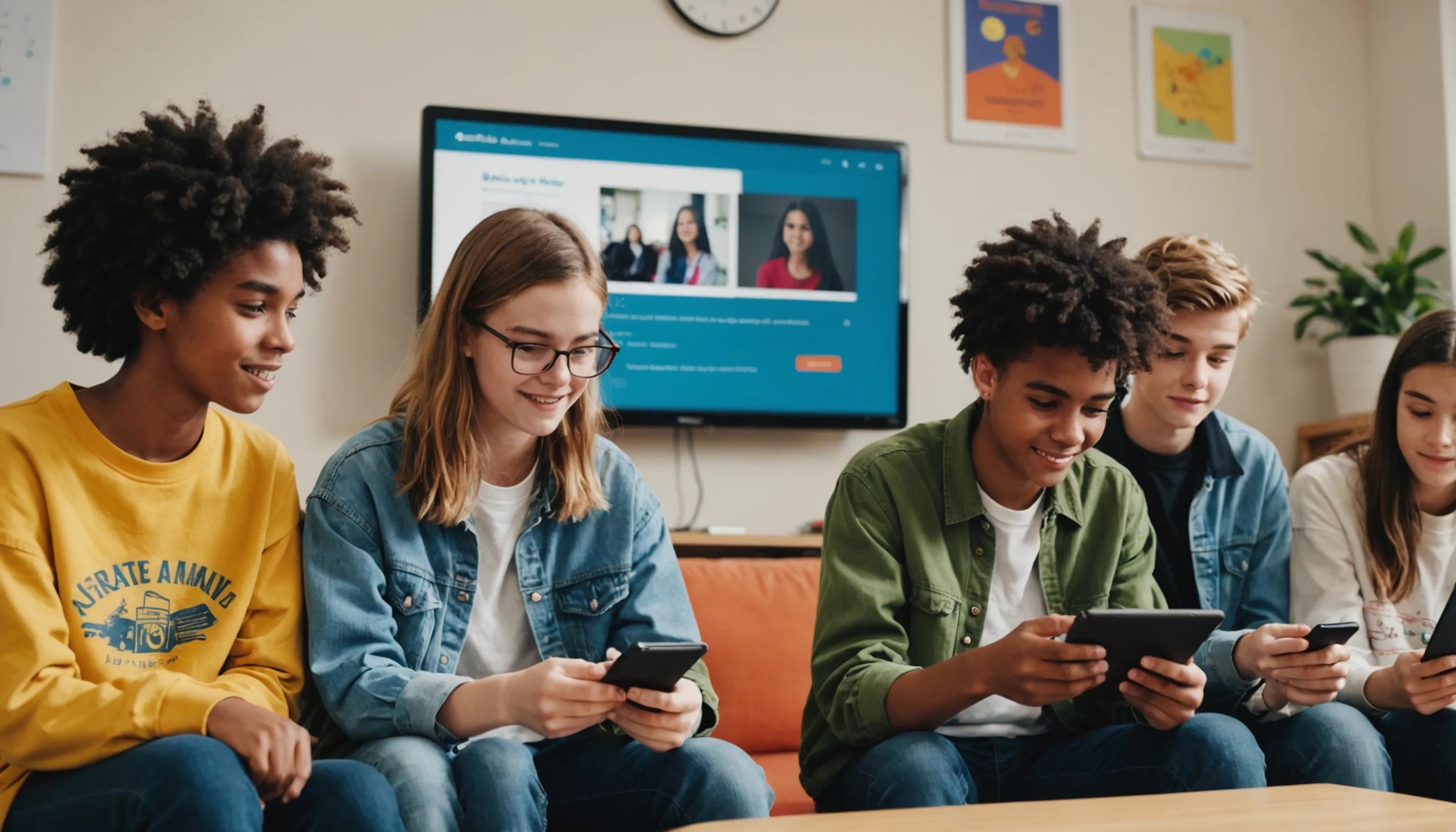If Kids Could Convert Screen Time into Learning Experiences
 HvWHenry van Wagenberg
HvWHenry van Wagenberg
Transforming Screen Time into Learning Experiences for Teens
Transforming screen time into valuable learning experiences for teens can have a significant impact on their educational journey. Parents and teachers can harness the power of technology by encouraging the use of educational apps and resources that promote critical thinking and creativity. By integrating these tools into daily routines, teens can engage with content that enhances their knowledge while enjoying their screen time.
It's essential to guide them in selecting high-quality, age-appropriate materials that align with their interests and curriculum. This approach not only maximizes screen time but also nurtures a love for learning.
Understanding Screen Time: Benefits and Drawbacks
Understanding screen time is crucial for parents and teachers as it plays a significant role in teens' lives today. While screens can provide numerous benefits, they also come with drawbacks that warrant careful consideration.
On one hand, screen time can be beneficial in several ways:
- Access to Information: The internet offers vast resources, allowing teens to explore topics of interest and conduct research for school projects.
- Skill Development: Many educational games and apps help develop critical skills, such as problem-solving, coding, and language acquisition.
- Social Connection: Technology enables teens to connect with peers, fostering social relationships, especially in an increasingly digital world.
However, it's essential to recognize the potential drawbacks:
- Physical Health Issues: Excessive screen time can contribute to a sedentary lifestyle, leading to health problems like obesity and poor posture.
- Mental Health Concerns: Overuse of screens can lead to anxiety, depression, and feelings of isolation, especially when social interactions occur primarily online.
- Distraction from Studies: Many teens struggle to balance academic responsibilities with recreational screen time, which can negatively impact their grades.
In conclusion, understanding both the benefits and drawbacks of screen time allows parents and teachers to make informed decisions about how to integrate technology effectively into teens' lives, promoting healthy habits and enriching learning experiences.

The Importance of Educational Content
The importance of educational content in shaping teenagers' screen time cannot be overstated. As technology becomes an integral part of their daily lives, ensuring that the content they consume is both enriching and informative is crucial for their development.
Educational content serves several essential purposes:
- Enhancing Knowledge: Quality educational materials provide teens with access to a wealth of information across various subjects, helping them expand their knowledge base beyond the traditional classroom setting.
- Promoting Critical Thinking: Engaging with educational content encourages teens to think critically and analytically. This fosters the ability to evaluate information, form reasoned arguments, and make informed decisions.
- Supporting Diverse Learning Styles: Educational content comes in various formats, such as videos, articles, podcasts, and interactive apps, catering to different learning preferences. This diversity allows teens to engage with material that resonates with them, enhancing retention and understanding.
Moreover, educational content can inspire creativity and innovation. Many platforms offer opportunities for teens to create their own projects, whether through coding, graphic design, or writing. This hands-on engagement not only solidifies learning but also cultivates valuable skills for their future careers.
By prioritizing educational content in their screen time, parents and teachers can help teenagers develop a lifelong love for learning, equipping them with the tools to thrive academically and personally in an ever-evolving world.
Setting Boundaries for Screen Time
Setting boundaries for screen time is essential for promoting healthy habits among teens. Establishing clear rules helps ensure that technology is used responsibly and productively. Parents and teachers can implement strategies such as:
- Defining specific hours for screen use, allowing time for homework and family activities.
- Encouraging regular breaks to prevent fatigue and promote physical activity.
- Monitoring the content consumed, ensuring it is educational and age-appropriate.
By creating a balanced approach to screen time, teens can enjoy the benefits of technology while minimizing its potential downsides.

Strategies for Parents and Teachers
Implementing effective strategies for parents and teachers is vital to help teenagers navigate their screen time productively. By working together, they can create an environment that fosters healthy technology use while promoting learning and engagement.
Here are some practical strategies:
- Establish Clear Guidelines: Parents and teachers should collaborate to set clear expectations regarding screen time. This includes defining when, where, and how long teens can use devices, ensuring that these guidelines are reasonable and age-appropriate.
- Encourage Educational Choices: Introduce teens to a variety of educational apps, websites, and online courses that align with their interests. This not only promotes learning but also helps them see the value of using technology positively.
- Create Tech-Free Zones: Designate specific areas in the home or classroom where screens are not allowed, such as during meals or in bedrooms. This encourages face-to-face interaction and helps establish a routine that values offline activities.
- Monitor Usage Together: Regularly review the content teens engage with on their devices. This not only keeps parents and teachers informed but also opens up discussions about what they are learning and enjoying.
- Model Healthy Behavior: Parents and teachers should model appropriate screen use by demonstrating balanced habits themselves. Engaging in screen-free activities together, such as reading or outdoor sports, can reinforce positive behaviors.
By employing these strategies, parents and teachers can help teens develop a healthy relationship with technology, ensuring that screen time becomes a tool for growth and learning rather than a source of distraction.
Encouraging Active Engagement with Technology
Encouraging active engagement with technology is crucial for helping teenagers maximize the benefits of their screen time. Instead of passive consumption of content, fostering an interactive and participatory approach can lead to deeper learning and skill development.
Here are some effective methods to promote active engagement:
- Incorporate Interactive Learning Tools: Utilize educational platforms that offer interactive lessons, quizzes, and hands-on activities. These tools not only capture teens' attention but also allow them to apply knowledge in real-time, enhancing retention.
- Encourage Creative Projects: Motivate teens to create their own content, whether it be blogs, videos, or podcasts. This not only hones their technical skills but also fosters creativity and critical thinking as they explore topics they are passionate about.
- Facilitate Group Collaboration: Encourage teens to work on group projects using technology. Whether through shared documents or collaborative apps, working together can enhance teamwork skills and make learning more enjoyable.
- Promote Online Discussions: Use online forums or social media groups related to educational topics. Engaging in discussions allows teens to express their opinions, ask questions, and learn from diverse perspectives.
- Set Goals and Reflect: Help teens set specific goals for their screen time, whether it's completing a course or mastering a skill. Encourage them to reflect on their progress and what they’ve learned, fostering a growth mindset.
By encouraging active engagement with technology, parents and teachers can empower teens to become proactive learners, equipping them with the skills necessary for success in an increasingly digital world.
Integrating Learning Apps and Resources
Integrating learning apps and resources into teenagers' screen time can significantly enhance their educational experience. By selecting high-quality apps that align with their interests and academic needs, parents and teachers can turn screen time into productive learning moments. Apps that focus on subjects like math, science, or languages can provide interactive lessons and quizzes that engage students actively.
Additionally, using resources such as online courses and educational videos can supplement traditional learning methods. Encouraging teens to explore these tools fosters independence and promotes a lifelong love for learning, making technology an ally in their educational journey.
Recommended Educational Apps for Teens
Choosing the right educational apps can greatly enhance teens' learning experiences while using technology. Here’s a list of recommended apps that cater to various subjects and interests:
- Khan Academy: This app offers a wide range of free courses in subjects such as math, science, and humanities. It features interactive exercises, instructional videos, and personalized learning dashboards that allow teens to learn at their own pace.
- Duolingo: An engaging language-learning app that makes acquiring a new language fun through gamified lessons. Teens can practice vocabulary and grammar while competing with friends.
- Quizlet: A study tool that allows students to create flashcards and quizzes for any subject. The app’s interactive learning modes help reinforce knowledge and improve retention.
- Evernote: This organizational app helps teens keep track of notes, assignments, and deadlines. Its versatility allows for the integration of text, images, and audio, making studying more efficient.
- Edmodo: A social learning platform that connects students and teachers. It provides a space for collaboration, discussion, and resource sharing, enhancing classroom engagement.
- Scratch: A programming app designed for beginners that allows teens to create their own interactive stories, games, and animations. This fosters creativity and introduces coding concepts in a fun way.
By incorporating these recommended educational apps into their routine, teens can engage with learning materials more effectively, turning their screen time into a productive and enriching experience.
Creating a Learning Plan Around Screen Time
Creating a learning plan around screen time is essential for maximizing the educational benefits of technology while ensuring that teens engage in a balanced approach to their digital consumption. A structured plan helps parents and teachers guide teens in integrating learning with leisure effectively.
Here are some steps to consider when developing a learning plan:
- Assess Interests and Goals: Start by discussing with teens their academic interests and personal goals. Understanding what they want to achieve will help tailor the learning plan to be more relevant and engaging.
- Set Clear Objectives: Define specific learning objectives, such as completing a certain number of online courses, reading specific books, or mastering particular skills. This clarity helps keep teens focused and motivated.
- Allocate Time for Learning: Designate specific time blocks within their screen time for educational activities. For instance, set aside an hour after school for using learning apps or watching educational videos, ensuring that it’s a priority in their daily routine.
- Incorporate Variety: Mix different types of content to keep engagement high. Include a combination of interactive apps, videos, podcasts, and reading materials that cater to diverse learning styles.
- Encourage Reflection: At the end of each week, encourage teens to reflect on what they've learned and how they can apply it. This practice reinforces knowledge and promotes a growth mindset.
By creating a thoughtful learning plan around screen time, parents and teachers can help teens develop a healthy relationship with technology while fostering a commitment to lifelong learning.
